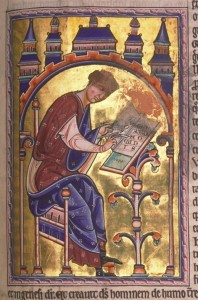


Photo: The Aberdeen Bestiary Website (https://www.abdn.ac.uk/bestiary/comment/81risidf.hti; consulted 12/4/15)
Welcome to the new website of the Index of Christian Art. Our updated and more user-friendly design preserves many of the things researchers have counted on finding here: information about our history, holdings, and hours; additional image resources; news about events and publications, including the annual journal Studies in Iconography; and a link to our online database. However, it now also includes updated information about our staff and their projects, new information about our resources and services, and periodic blog posts on topics of interest to a range of medievalist researchers.
Our website redesign, created by our Technology Manager Jon Niola with content input from several of our research staff, represents only one of several initiatives under way at the Index this year. The most important to external researchers will be a total revamp of our venerable online database to allow for a friendlier design, more flexible, intuitive searches, and easier access to information and images. We hope to put this into place in time for the Index’s centennial in 2017. Other initiatives include the inauguration of Index Workshops, in which faculty and students in the department of Art & Archaeology at Princeton can join with Index and area scholars to workshop papers and publications in progress, and the revival of the well-known Index Conference Series, which reboots on April 29 with a one-day conference titled “Plus Ça Change? The Lives and Afterlives of Medieval Iconography.”
We would like to think that our technological updates would please St. Isidore of Seville (ca. 560-636), who in 1997 was nominated by Pope John Paul II to become patron saint of the Internet. Bishop of Seville for over thirty years, the learned Isidore richly deserves the honor: his most famous work, the 20-volume Etymologiae, attempted to summarize all human knowledge in the manner of Classical scholars. Its scope ranges from theology and the liberal arts to medicine, animals, and daily life, offering the reader a plethora of surprising and sometimes colorful details about such topics as the causes of an eclipse, the behavior of ants, and the names of various women’s garments. Its wide use and continued importance throughout the Middle Ages can be judged by its countless citations (dare we call them re-tweets?) in works by medieval authors, including such luminaries as Dante, Chaucer, Bocaccio, and Petrarch. Isidore of Seville is represented by 28 records in the Index, both in the database and physical card file; he is often shown writing busily at a lectern, as in the late twelfth-century Aberdeen Bestiary (Aberdeen University Library, MS. 24, fol. 81r). Further subject references to Isidore can be found under, “Clergy, Bishop: Isidore of Seville” and “Scribe, Male: Isidore of Seville.”